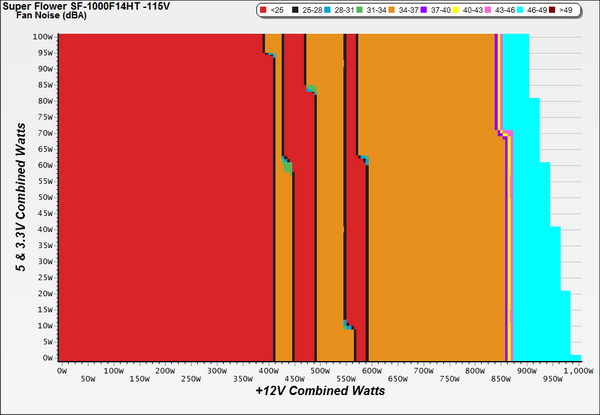Super Flower Leadex Titanium 1000W PSU Review
Super Flower was one of the first companies to release an 80 Plus Titanium-rated PSU. Following the ultra-high-capacity SF-1600F14H unit, the company released two more Titanium PSUs, one of which we're evaluating today.
Why you can trust Tom's Hardware
Efficiency, Temperature And Noise
Efficiency
Our efficiency testing procedure is detailed here.
Using the results from the previous page, we plotted a chart showing the SF-1000F-14HT's efficiency at low loads, and loads from 10 to 110 percent of the PSU's maximum-rated capacity.
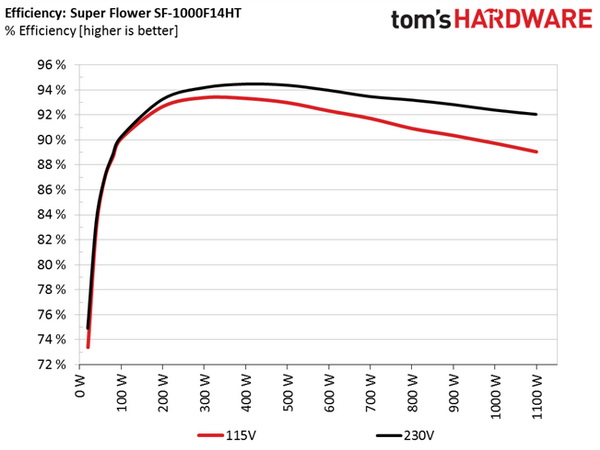
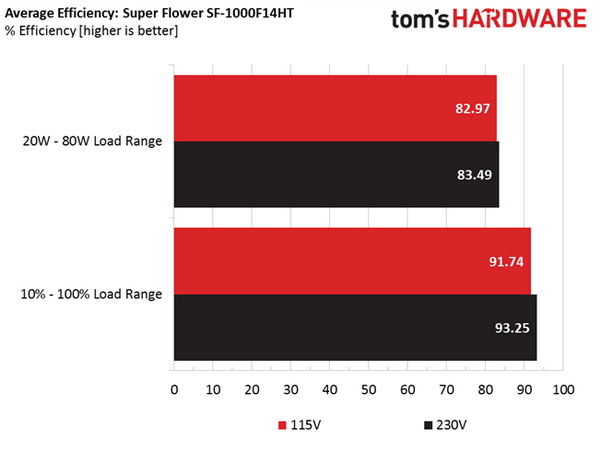
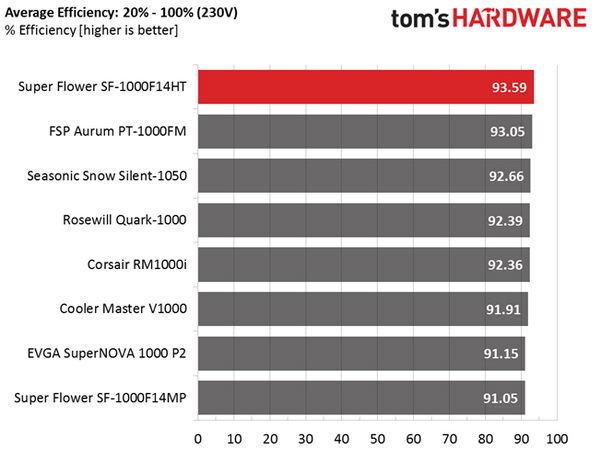

Since our database doesn't include another similar capacity unit with an 80 Plus Titanium rating, Super Flower's PSU easily takes first place on our charts. As you can see, the efficiency difference at normal loads between the SF-1000F-14HT and a good Platinum-rated unit varies from 0.5 to 0.9 percent. Under low loads, the efficiency gap becomes 2.3 percent.
Efficiency At Low Loads
In the following tests, we measure the efficiency of the SF-1000F-14HT at loads significantly lower than 10 percent of the device's maximum capacity (the lowest load the 80 Plus standard measures). The loads we dialed were 20, 40, 60 and 80W. This is important for representing when a PC is idle, with power-saving features turned on.
| Test # | 12V | 5V | 3.3V | 5VSB | DC/AC (Watts) | Efficiency | Fan Speed (RPM) | Fan Noise (dB[A]) | PF/AC Volts |
|---|---|---|---|---|---|---|---|---|---|
| 1 | 1.200A | 0.491A | 0.481A | 0.196A | 19.67 | 73.37% | 0 | 0 dB(A) | 0.812 |
| 12.169V | 5.044V | 3.314V | 5.072V | 26.81 | 115.1V | ||||
| 2 | 2.420A | 0.990A | 0.995A | 0.389A | 39.70 | 82.97% | 0 | 0 dB(A) | 0.921 |
| 12.168V | 5.040V | 3.313V | 5.068V | 47.85 | 115.1V | ||||
| 3 | 3.653A | 1.475A | 1.510A | 5.064A | 59.85 | 86.92% | 0 | 0 dB(A) | 0.955 |
| 12.165V | 5.038V | 3.311V | 5.064V | 68.86 | 115.1V | ||||
| 4 | 4.863A | 1.983A | 1.991A | 0.790A | 79.73 | 88.62% | 0 | 0 dB(A) | 0.967 |
| 12.164V | 5.036V | 3.310V | 5.059V | 89.97 | 115.1V |
Efficiency is amazing under low loads, especially if we take into account that this is a 1kW PSU, which is at a disadvantage compared to lower-capacity power supplies.
5VSB Efficiency
The ATX specification states that 5VSB standby supply efficiency should be as high as possible, recommending 50 percent or higher efficiency with 100mA of load, 60 percent or higher with 250mA of load and 70 percent or higher with 1A or more of load.
We will take four measurements: one each at 100, 250 and 1000mA, and one with the full load the 5VSB rail can handle.
Get Tom's Hardware's best news and in-depth reviews, straight to your inbox.
| Test # | 5VSB | DC/AC (Watts) | Efficiency | PF/AC Volts |
|---|---|---|---|---|
| 1 | 0.102A | 0.51 | 69.86% | 0.046 |
| 5.074V | 0.73 | 115.1V | ||
| 2 | 0.252A | 1.27 | 76.97% | 0.100 |
| 5.070V | 1.65 | 207.5V | ||
| 3 | 1.002A | 5.07 | 80.10% | 0.287 |
| 5.056V | 6.33 | 115.1V | ||
| 4 | 2.502A | 12.58 | 79.32% | 0.422 |
| 5.026V | 15.86 | 115.1V |
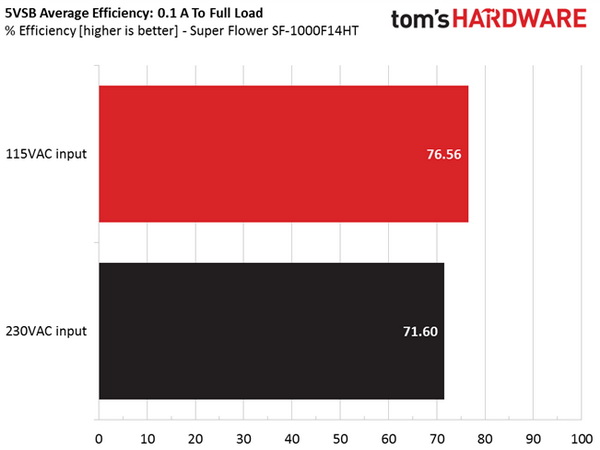
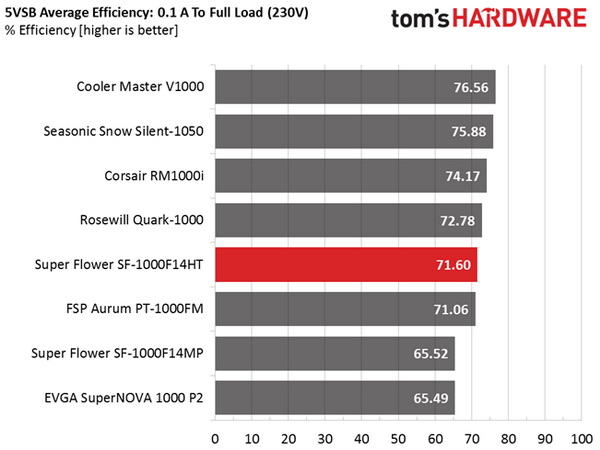
The 5VSB rail achieved good performance and high efficiency overall. Our only complaint is the rail's low capacity. We would like to see it with at least 3A of maximum current output in a 1kW PSU.
Power Consumption In Idle And Standby
| Mode | 12V | 5V | 3.3V | 5VSB | Watts | PF/AC Volts |
|---|---|---|---|---|---|---|
| Idle | 12.171V | 5.047V | 3.315V | 5.079V | 5.68 | 0.316 |
| 115.1V | ||||||
| Standby | 0.11 | 0.007 | ||||
| 115.1V |
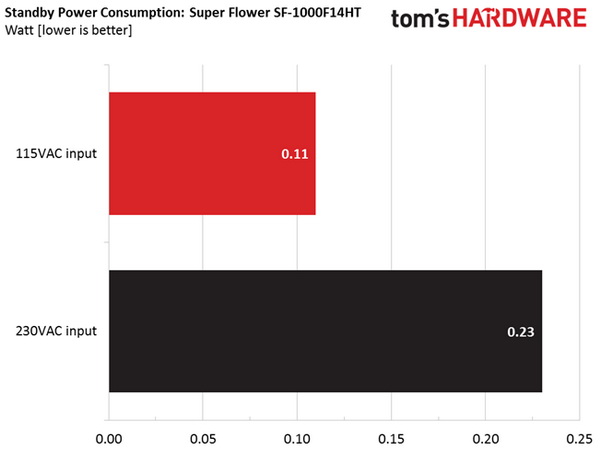
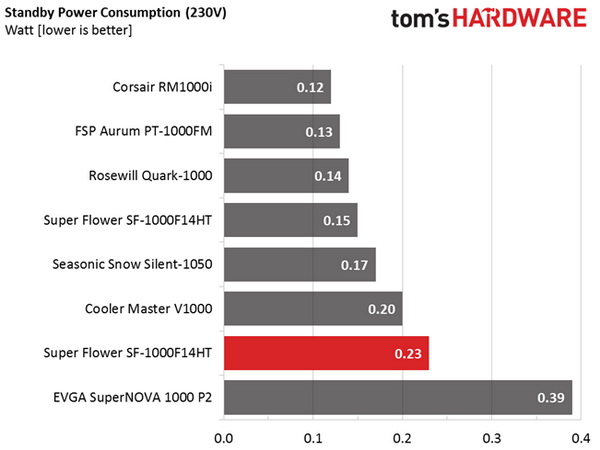
In the table above, you'll find the power consumption and voltage values of all rails (except -12V) when the PSU is idle (powered on, but without any load on its rails), and the power consumption when the PSU is in standby mode (without any load, at 5VSB).
Phantom power with 115V input is quite low. However, it's a little higher than we'd expect with 230V. This is why the 5VSB rail isn't particularly efficient at that input level, at least under low loads.
Fan RPM, Delta Temperature And Output Noise
Our mixed noise testing is described in detail here.
The first chart below illustrates the cooling fan's speed in RPMs, and the delta between input and output temperature. The results were obtained at 35 °C (95 °F) to 48 °C (118.4 °F) ambient temperature.
The next chart shows the cooling fan's speed and output noise. We measured acoustics from one meter away, inside a small, custom-made anechoic chamber with internals completely covered in sound-proofing material (be quiet! Noise Absorber kit). Background noise inside the chamber was below 18 dB(A) during testing, and the results were obtained with the PSU operating at 35 °C (95 °F) to 48 °C (118.4 °F) ambient temperature.
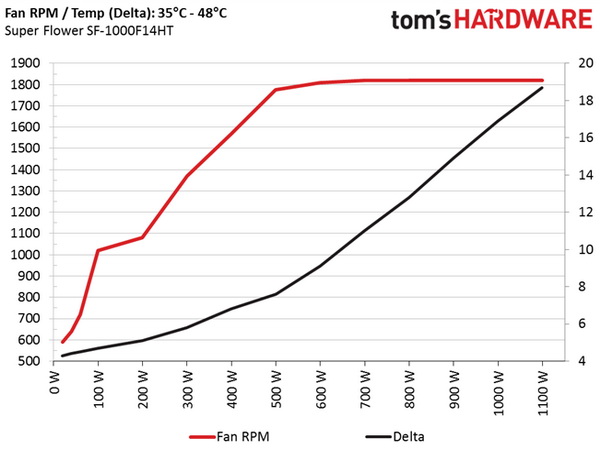
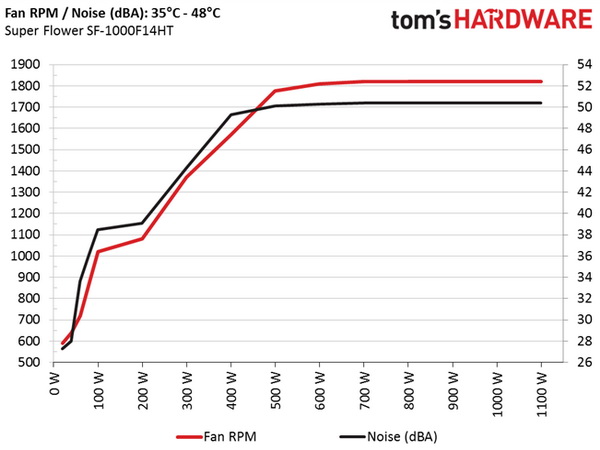
The following graph illustrates the fan's output noise over the entire operating range of the PSU. The same conditions of the above graph apply to our measurements, though the ambient temperature was between at 28 °C (82.4 °F) to 30 °C (86 °F).
Under normal operating temperatures, the passive mode lasts a long time. Up to around 400W of load, the fan doesn't engage at all. Beyond that, it kicks in at under 1000 RPM. When the internals of the PSU cool down, the PSU drops back into passive mode again for a short period, after which the fan started up at low speed. Only when the load level exceeded 850W did the fan accelerate to ~1400 RPM. The fan's speed never hit 1800 RPM in our tests, which is the max.
Current page: Efficiency, Temperature And Noise
Prev Page Load Regulation, Hold-Up Time And Inrush Current Next Page Cross-Load Tests And Infrared Images
Aris Mpitziopoulos is a contributing editor at Tom's Hardware, covering PSUs.
-
AnimeMania Are modular cables interchangeable between the different power supply vendors or will this happen in the future.Reply -
blazorthon ReplyAre modular cables interchangeable between the different power supply vendors or will this happen in the future.
Some might be, but generally, don't expect interchangeable cables. There are many different implementations for the connectors for one reason or another. -
Aris_Mp ReplyAre modular cables interchangeable between the different power supply vendors or will this happen in the future.
It highly recommended to assume that they are not, even when the PSU is made by the same manufacturer.
-
Aris_Mp ReplySo, ah, what did you use as a price?
We used the price sold in EU stores, excluding the VAT of course. -
babernet_1 Reply17269051 said:So, ah, what did you use as a price?
We used the price sold in EU stores, excluding the VAT of course.
Which is? I looked and saw a price of 200 euro. That's about $220. Does it include VAT? -
babernet_1 Reply17273936 said:yes, in EU most stores include VAT in their prices.
My gosh! I just want to know in dollars what your estimated price was!
:??: -
Andi lim Using a bunch of KRG series capacitor for extra suppress ripple in Titanium PSU ?Reply
The Analogy : you want to build a super car, lets say Nissan GTR, but at the end you decide to use some cheap parts from Datsun on to your car, hahahaha.
The Question is, How long this PSU will stay in titanium level efficiency ?
Let's say after a year usage, the standard and cheap KRG capacitor will slowly increace the ESR, leak current dan temperature. at that time, this PSU efficient will go to platinum level or below ? Only time will tell.
